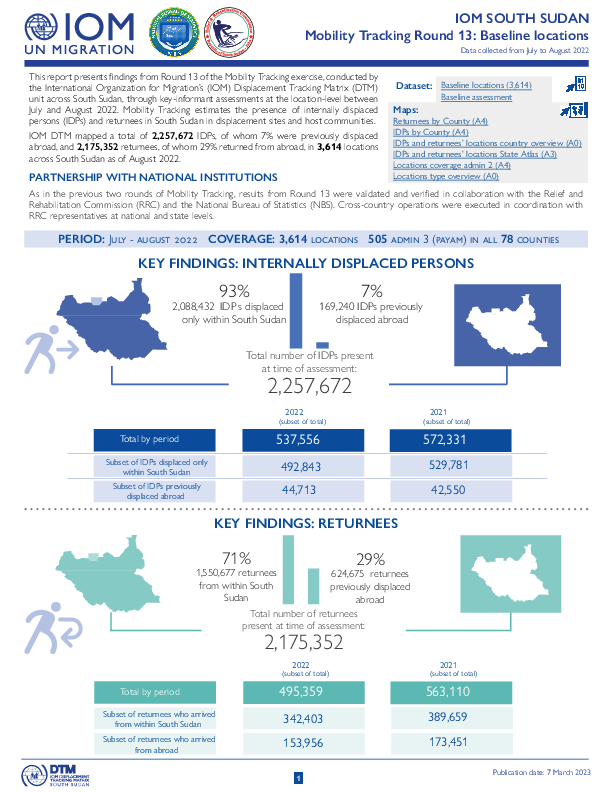-
Countries
-
Data and Analysis
-
Special Focus
-
Crisis Responses
Mar 07 2023
Print
Mar 07 2023
Print
Irish Embassy

Contact
DTM South Sudan, SouthSudanDTM@iom.int
Language
English
Location
South Sudan
Period Covered
Jul 01 2022
Aug 31 2022
Activity
- Mobility Tracking
- Baseline Assessment
This summary presents initial findings from Round 13 of Mobility Tracking conducted across South Sudan through key-informant assessments at location-level in August 2022. Mobility Tracking estimates the presence of internally displaced persons (IDPs) and returnees in South Sudan in displacement sites and host communities. IOM DTM mapped a total of 2,257,672 IDPs, of whom 7% were previously displaced abroad, and 2,175,352 returnees, of whom 29% returned from abroad, in 3,614 locations across South Sudan as of August 2022.

Contact
DTM Yemen, DTMYemen@iom.int
Language
English
Location
Yemen
Period Covered
Jan 01 2022
Dec 31 2022
Activity
- Flow Monitoring
Yemen, despite the ongoing humanitarian crises in the country, continues to be a major transit point along the eastern migration route between the Horn of Africa (HoA) and the Kingdom of Saudi Arabic (KSA). IOM’s DTM recorded 73,233 migrant arrivals in Yemen in 2022, through operating at key migrant landing locations along the southern coast in the governorates of Lahj, Shabwah, and Hadramawt. Irregular migrants, mainly from Ethiopia, travel to Yemen via boats, from Djibouti and Somalia, and face severe protection risks, which worsen upon arrival in Yemen.
The main migration route starts from Ethiopia to the seaport city of Obock in Djibouti. Migrants then depart Obock and arrive at Bab Al Mandeb Strait, an area that spans the coasts of Lahj and Ta’iz governorates. A secondary route via Somalia gained traction during increased military patrolling along the main route between Djibouti and Yemen. More migrants departed from Bossaso in Somalia arriving at the coasts of Shabwah and Hadramawt than from Djibouti during six non-consecutive months of the year (January, March, June-September). The journey along this route is said to be longer and more precarious.
The majority of migrants intend to reach Saudi Arabia (97%) but for most, as DTM field staff have observed, their transit in Yemen can last months to years. Migrants attempt to reach KSA through the Monabih district in Sa’dah governorate, mainly through Al Raq, Al Gar and Al Thabet towns which fall on the northern border.
In pursuit of better economic opportunities, migrants endure heightened inhumane conditions. Migrants are amongst the most underserved, marginalized and at-risk population groups in Yemen. With the deepening of the political and security crisis in Yemen, migration dynamics in the country have remained perilous. Migration trends seemed unaffected by the conflict as the influx of migrants was the lowest during the time of truce in 2022 (April to October). Many migrants DTM staff talked to were not aware of the war. Trends seem more related to seasonal and otherwise changing weather conditions at sea as well as security measures on Djiboutian or even Sudi Arabian borders.
Fleeing destitution, poverty and often violence, migrants in Yemen experience aggression, abuse and exploitation. The majority are living in dire conditions with extremely limited-to-no access to essential services such as shelter, food, water and healthcare.

Contact
DTM Mozambique, DTMMozambique@iom.int
Language
English
Location
Mozambique
Period Covered
Feb 24 2023
Mar 06 2023
Activity
- Other
Mozambique’s National Institute for Disaster Management (INGD) estimates 1.75 million people to be affected by recent floods and subsequent landfall of the tropical storm Freddy across central and southern Mozambique. Making landfall on 24 February 2023, Tropical Storm Freddy has impacted the provinces of Gaza, Inhambane, Sofala and Zambezia. As of 06 March 2023, available reports indicate 8,111 individuals (1,923 families) have taken shelter in 10 accommodation centres (ACs) across Sofala, 3,828 individuals (877 families) in 17 ACs across Inhambane, 1,461 individuals (223 families) in 5 ACs in Gaza and 313 individuals (78 families) in 2 ACs in Zambezia. The majority of these centres are schools and churches. Reported priority needs include WASH, protection, health, food and emergency shelters. As rain and flood conditions develop, ongoing joint assessments with INGD and humanitarian partners monitor the needs and conditions of affected populations in the region. For further information see Mozambique: Severe Tropical Storm Freddy and Floods - Flash Update No.5 (as of 26 February 2023).

Contact
DTM Pakistan, iomisbdtmremapteam@iom.int
Language
English
Location
Pakistan
Period Covered
Jan 01 2022
Dec 31 2022
Activity
- Flow Monitoring
This yearly summary report, in addition to bi-weekly and quarterly reports, aims to contribute to a better understanding of return movements of undocumented Afghan returnees by conducting more in-depth analysis on the data that was collected in 2022.
According to the analysis, the number of undocumented Afghans returning from Pakistan has increased significantly, nearly threefold, in comparison to 2021. This rise in returns can be attributed to the significant geopolitical changes that took place in Afghanistan between 2021 and 2022. The data also shows that the number of undocumented Afghans leaving the country was higher in the last quarter at Torkham border and in the first quarter at Chaman border. This increase in undocumented returnees is mostly due to the relaxation of border restrictions compared to the previous year.



